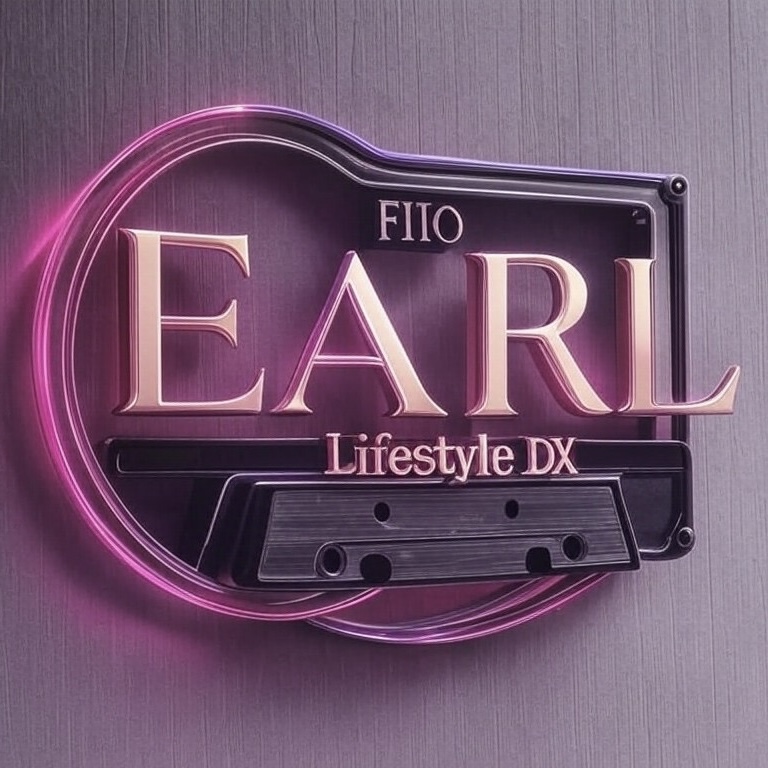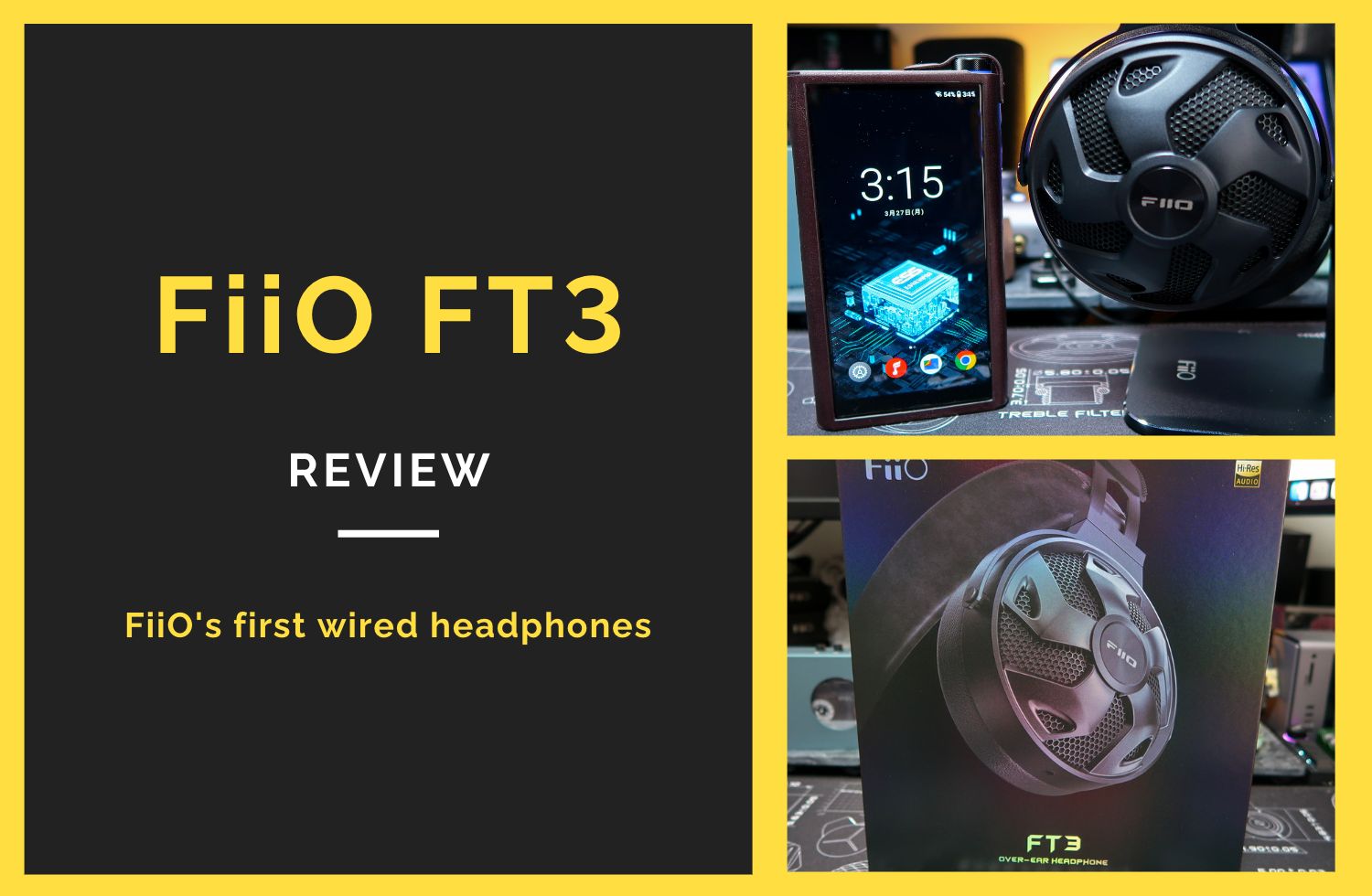
*Attention:This English version is written by machine translation of the Japanese review article.
This article is an actual review of the FiiO FT3. This article includes an initial review of the FiiO FT3 a few hours after opening the package and a review of over 100 hours of listening.
First, let us briefly introduce the main features of the FiiO FT3. This FiiO FT3 has a large 60mm dynamic driver (DD). The FT3’s DD is a beryllium-plated gasket + DLC diaphragm. And although the FT3 is made of aluminum alloy metal, its weight is kept to 391g. It is also designed for extended use, with three-axis steering. Finally, the FT3 has a high impedance of 350 ohms and a sensitivity of 102 dB. The sensitivity does not seem to indicate that the headphones are particularly difficult to hear, but they are headphones that require a certain level of output performance.

Summary
To sum up, I found the sound of the FiiO FT3s to be more low midrange and warm in tone immediately after opening the package (before the burn-in). However, after 50 hours, the overall sound of the FT3 began to change, and the sound, which I felt was more in the mid-low range, became flatter, almost V-shaped, with the mid-high to high range emerging. The sound balance of the FiiO FT3 is flat, with the mid-high range being the main focus. And the sound of the FT3 is a sound that even those who like FiiO’s FD7 and FD5 will like. This is what the subtitle means.
On the other hand, the high impedance of 350 ohms and the large 60mm driver result in a narrow soundstage, mixed sound, and a lack of low frequencies if a DAP/DAC or other device is not capable of playing the FT3s. Therefore, these headphones require an upstream with a certain level of output power. Finally, despite weighing 391g, the FiiO FT3s are comfortable to wear for 5-7 hours.
Pros
- The fit is very good, and it is hard to feel the weight.
- The high frequency range is smooth and not piercing, while the mid and high frequency range is extended.
- High resolution
- Low frequencies with depth and speed
Cons
- The attached cable is long (3m).
- Certain level of output performance is required.
Overview
This article will excerpt and itemize the main characteristics.
- Large 60mm dynamic driver
- Beryllium-plated gasket + DLC diaphragm
- High impedance of 350Ω (sensitivity of 102dB)
- Playback frequency range: 7Hz-40kHz
- Weight: 391g
- Headphone connector: 2-pole 3.5mm/double-sided
- Cable made of monocrystalline copper from Furukawa Electric (length: 3m)
- 3-axis steering
- Rigid yet lightweight aluminum alloy body
- Open-type
- Drivers are placed at an angle parallel to the ear (drivers are placed at a slight angle to the main body)
- Two types of ear pads (leather/velour)
- Interchangeable 3.5/4.4 plugs and 6.35mm/XLR balanced conversion adapter included
- Leather storage bag
In addition to the FT3, a headphone with the model number FT5 is planned for 2023. Although the FT3 and FT5 have different model numbers, they do not seem to have a hierarchical relationship. The reason for this is that, unlike the FT3, the FiiO FT5 will use planar drivers. Therefore, they are two headphones with different positions. Incidentally, this will be FiiO’s first wired headphone, but they have released a wireless headphone called EH3NC in 2019, and this FT3 seems to make use of the know-how gained from that.
Package
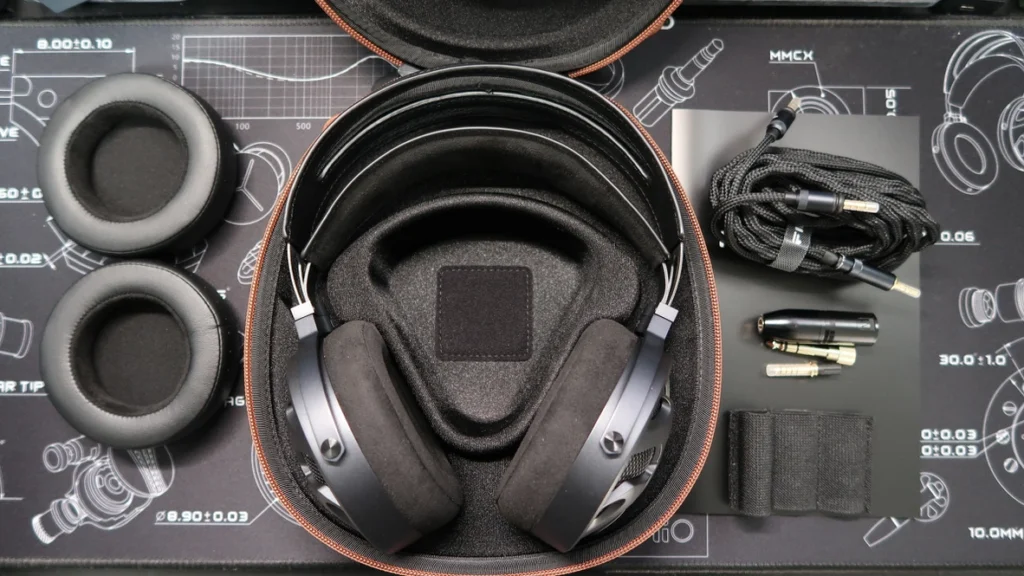
The photo above shows the list of items included in the package, as follows.
- FT3 main unit
- Cable (3m / 3.5mm as default)
- 2 types of earpads (velour earpads are initially equipped)
- 4.4mm interchangeable plug
- 6.35mm, XLR balanced conversion adapter
- Leather case
- Manual
The FiiO FT3 leather case is a quality case. Also, balanced connection is available with the accessories, and two types of earpads are included. So even if you don’t have cables or ear pads on hand, the FT3 can provide them all with the accessories. However, the included cable is quite long at 3 meters. We asked FiiO if they are planning to offer a shorter cable, and they said they are planning to sell an upgrade cable for the headphones. However, details are unknown at this time.

This is about the cable specifications of the FiiO FT3. The cable is quite thick and bulky. However, it is soft and easy to handle. The headphone side is a 3.5mm 2-pole plug.
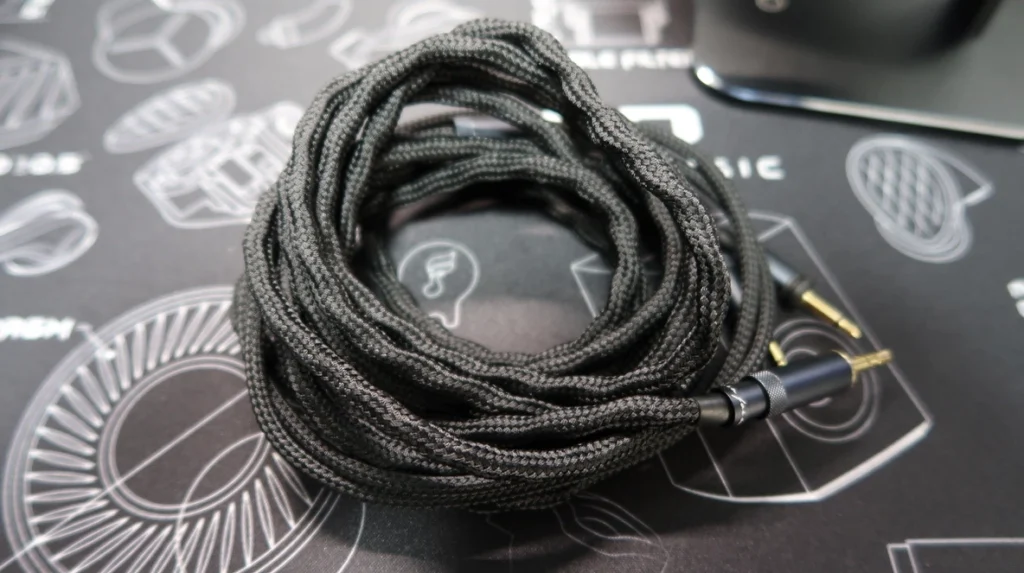
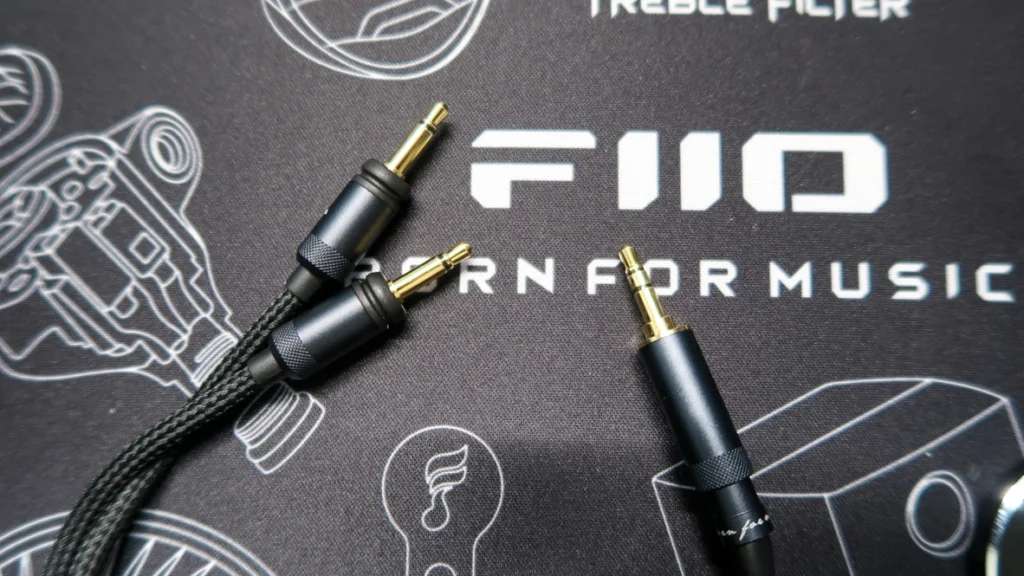
Design and Fitting
First, let’s look at the design of the FiiO FT3. I had imagined a metal-like, heavy texture from its aluminum alloy and black design, but the actual FT3 has a much lighter texture. To put it worse, it may look a little cheap depending on the viewing angle and the way reflections appear. The color texture is a matte gray rather than pitch black, and I think that’s the reason. looking at the FT3 up close, the aluminum alloy body is of high build quality, and the outside of the housing is pear-shaped, smooth, and textured. And the steering wheel is nice and smooth.

Next is the fitting of the FiiO FT3. Initially, I was concerned about the weight of 391g. In fact, I felt a bit of weight when I held it in my hand, but when I put it on my head, I did not feel its weight. One of the reasons for this weightlessness is the good fitting of the headband on the side that hits the head. The headband of the FiiO FT3 is very elastic. It fits snugly along the top of the head, distributing the weight and easing the burden. This also makes the top of the head less painful. Then there is the side pressure of the FiiO FT3. On my head, it felt a little weak. However, it is not so weak that it slips off, and even if I wear it for a long time, the side pressure seems to be less burdensome and less likely to cause pain in the temple area. The FiiO FT3’s three-axis steering system, which is one of the features of the FiiO FT3, fits well around the ear, so even if the side pressure is weak, it is difficult for it to shift. The FiiO FT3’s ear cups are wider and do not feel like they are hitting the ear. Because of these fitting qualities, despite the 391g metal specs, I wore the FT3s for 5-7 hours and experienced no neck fatigue, temple pain, or any other concerns.
Sound
*All are listened to through 3.5mmSE.
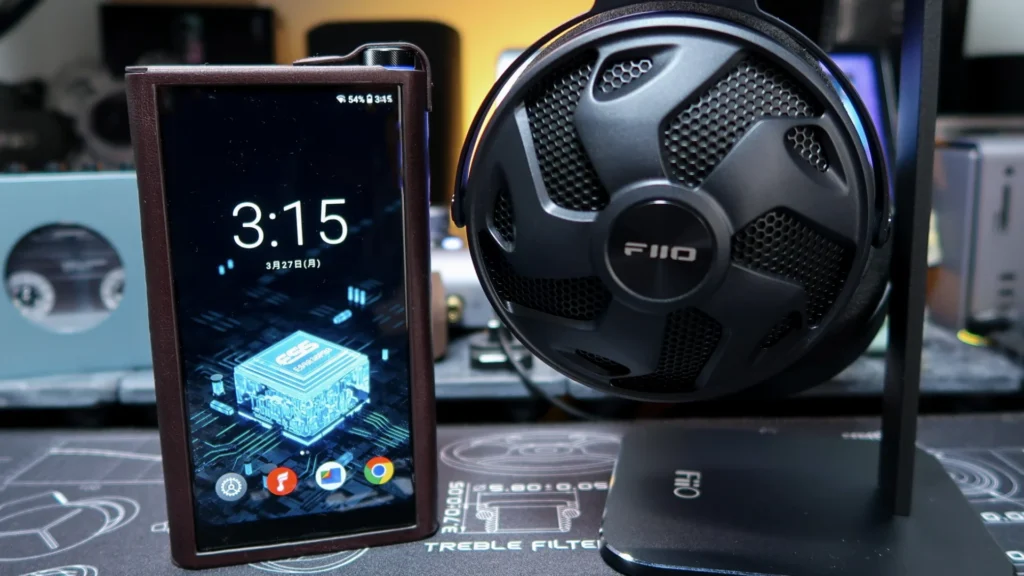
Initial review about 3 hours after opening the package.
I listened to all genres while changing upstream including M15S, K7, KA5, Q11, mojo2, etc.
The overall sound of the FiiO FT3 is very smooth. This smooth texture is also felt in the FiiO earphones released after the FH9. Returning to the FT3s, this smooth texture allows the FiiO FT3s to have controlled high frequencies without stinging, and vocals are not crushed by the low frequencies. The overall balance is warm and low-frequency. The overall balance is warmer and closer to the low midrange. However, the FiiO FT3’s low frequency range is clean rather than heavy, and it doesn’t feel like it is strongly leaning toward the mid-low range, making it a good match for songs where you want to hear vocals, such as Utada Hikaru and YOASOBI. Also, because the vocals are clearly audible, the sound is bright, even though it is closer to the lower midrange. However, depending on the music you listen to and the upstream (DAC/DAP, etc.), you may get the impression that the bass comes forward a little. The sound field and resolution of the FT3s are comparable to those of ordinary headphones.
The review is based mainly on the impression I got from listening to the 3.5mm single-ended, but when I also tried the balanced version, my impression of localization and sound resolution only changed, and I didn’t get the impression that they sounded or didn’t sound particularly good.
After 100+ hours of burn-in, review
In this FiiO FT3 review, I am listening mainly with the K9PRO. It is around 10 Japanese domestic tracks that I am listening to as reference.
To repeat the first statement, I concluded that the mid and high frequencies of the FiiO FT3 start to come forward around 50 hours, and that the mid and high frequencies are the main part of the sound after 100 hours. The sound balance is flat. While the mids and highs are prominent, the lows are deep and firm, not waist-high, and the balance makes it sound flat. The FiiO FT3 is characterized by three things. (1) The highs are smooth without being piercing, while the mids and highs take center stage. (2) is a sense of weight and speed due to the deep low frequency range. Although this overlaps with the previous point, the deep low-frequency range gives the sound a sense of weight, and the low-frequency range is sufficient for the extension of the high-frequency range. The low frequency range has a sense of speed and sharpness. Finally, the resolution is high. Even a song with many notes can be captured without mixing the vertical hierarchy. On the other hand, this is a disadvantage of FT3. The mid-high frequency range plays a leading role in some songs, so the sound field may seem a little narrower with vocals closer to the listener. In addition, FT3 does not have a strong sense of left/right separation and localization. This is not a problem if the left and right frequencies are clearly separated, but the weak sense of localization can make the sound field feel a bit cluttered at times.
And when these are not sounding, the disadvantages will be more colorful: if the FiiO FT3s are not sounding: the impression will change to lack of low frequency, narrow soundstage, and a cluttered feeling. Therefore, I think it is safe to use FiiO’s recommended list: K7, K9, K9PRO, K5PRO, M17, M15S, M15, Q7, or R7. On the other hand, in the following review of the sound of FT3 and DACs combined with each, there are some points where you can feel the benefits of FT3 even without sound, so the aforementioned list should be taken as an image of maximizing the performance of FT3 and enjoying it more. I believe that it is not true to say that you cannot enjoy FiiO FT3 at all if you do not have any of the models on this list. This is because I myself spend some time listening to the FT3 with the KA5 dongle-type DAC and the Q11 portable amplifier.
Paring
This is a review of each DAP/DAC paired with the FiiO FT3. This time it’s the same FiiO with the K9PRO and K7 from the stationary, the M15S DAP, the Q11 portable amp, and the KA5 dongle DAC.
With M15S
If I listen to FiiO FT3 for a long time, I like the combination with M15S the most. The reason for this is that the M15S has relatively warmer colors and milder solidity in the high frequencies than other DAP/DACs that use FiiO’s ESS. This makes the deep lows warmer and the highs smoother without sacrificing volume, and the center of gravity shifts a bit toward the lows from the neutral balance of the FT3. This combination makes the FT3s less tiring to listen to for long periods of time. Artists with distinctive high tone voices will also be relatively easier to listen to. On the other hand, the characteristic mid- and high-frequency extension of the FT3 is suppressed, resulting in a slightly darker sound. The soundstage is standard.
With K9PRO
Next is the FiiO FT3 paired with the K9PRO; when considering the FT3, I urge you to listen to it with the K9PRO. This combination provides the widest soundstage and drives the FT3 more strongly, which brings out the best of the FT3. It brings out the best of FT3, with its characteristic mid-range and high frequency extension and beautifully resonant highs. This is a combination that brings out the full potential of FT3. However, although the highs are properly controlled to a line that does not sting, the sound is solid, with a dry, monitor-like tone that can be a bit tiring to listen to. The M15S is good for extended listening, whereas the K9PRO is better for 2-3 hours of listening to FT3.
With K7
The combination of K7 and FiiO FT3 gives an impression similar to that of K9PRO. Simply put, it gives the impression of a slightly smaller scale compared to the K 9PRO combination. This makes the vocals sound a little more forward. However, it is enough to bring out the best of the FT3, and as it is in the recommended list, you can enjoy the sound of the FT3 itself.
With Q11
From here on, the FiiO FT3 and Q11 combination is a model that is not on FiiO’s recommended list; surprisingly, the soundstage sensation is similar to that of a stationary system. The sound field of the FiiO FT3 and Q11 combination is surprisingly similar to that of a stationary system, especially in terms of lateral expansion. The aural balance also feels close to that of the K7, from which the vocals seem a little closer. On the other hand, there is a lack of vertical extension in the high frequency range, and the low frequency range does not sink deep. On the other hand, around the midrange you can feel the FT3’s high resolution of detail. Although there is a slight sense of clutter due to the lack of control in complex songs, each note is crisp and clear, and the sound is enjoyable. Listening to Masaki Suda’s “Sayonara Elegy” with this Q11 and FT3 combination was very good.
With KA5
Finally, the FiiO FT3 is paired with the KA5. With this combination, you can enjoy all the advantages of the FT3: smooth sound, high detail expression, and high frequency extension. Although not on the recommended list, I personally also like this combination of KA5 and FT3. The soundstage is not as wide, but the FT3s are so well controlled that it sounds as if you are listening to high quality 1DD earphones. It expresses detail from low to high frequencies and has the resolution of a multi-BA earphone, and for me personally, it surpasses the FD7. Please try this combination as well.
That concludes our review of the FiiO FT3.
Thank you for reading to the end.
If you found this article helpful, please follow me on X(Twitter) as well. I am a fan of FiiO, summarize the latest news, and the fastest reviews.
